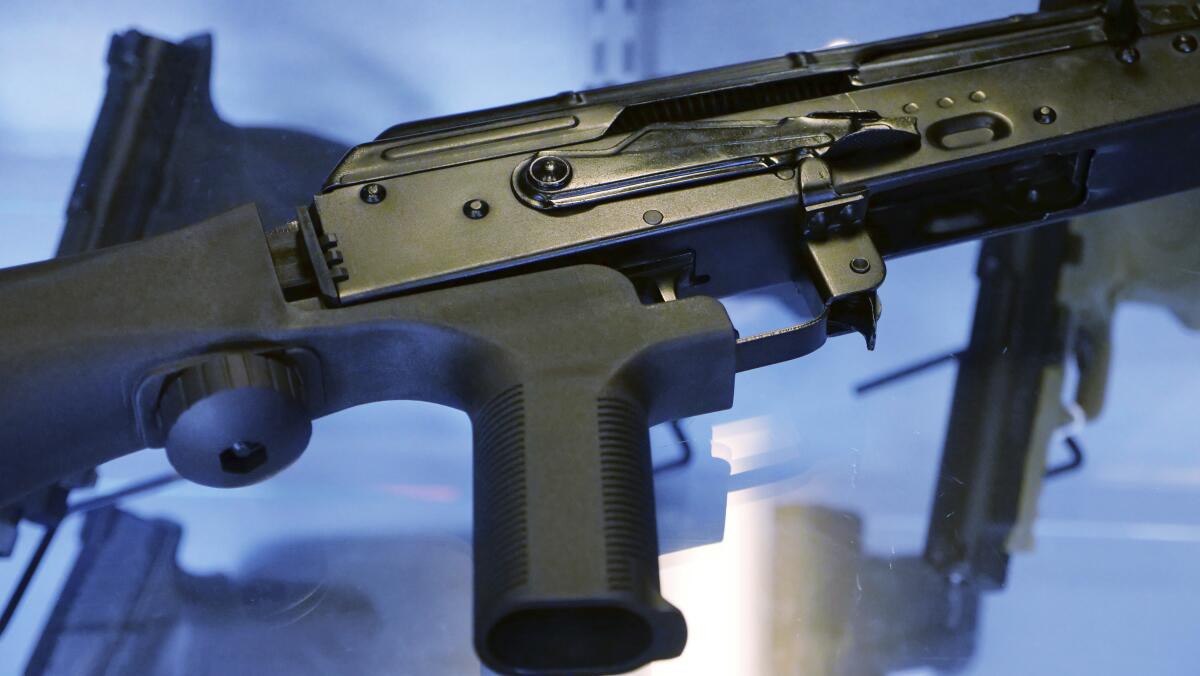Supreme Court appears to favor upholding ban on rapid-fire bump stocks

- Share via
WASHINGTON — The Supreme Court on Wednesday leaned in favor of upholding a Trump-era regulation that would outlaw bump stocks that enable rifles to work like machine guns and allow a shooter to spray hundreds of bullets per minute.
The justices, both conservative and liberal, said Congress had intended to forbid rapid-fire rifles as especially dangerous. And that could include devices that convert a legal semiautomatic gun into one that “produces a torrent of bullets with one pull of the trigger,” said Justice Elena Kagan.
It is a rare instance of a gun regulation that is supported by prominent Republicans as well as Democrats, but it now faces a court whose conservative justices are often skeptical of agencies issuing new regulations reinterpreting old laws.
Several of them voiced that concern during Wednesday’s argument.
Justices Neil M. Gorsuch and Amy Coney Barrett said it would have been better if Congress had revised the law after the mass shooting in Las Vegas in 2017.
But a Biden administration attorney said the Bureau of Alcohol, Tobacco, Firearms and Explosives had to take action.
“After the deadliest shooting in our nation’s history, I think it would have been irresponsible for the ATF not to take another closer look at this,” Deputy Solicitor Gen. Brian Fletcher told the court.
On Oct. 1, 2017, a gunman on an upper floor of a Las Vegas hotel fired more than 1,000 rounds in 11 minutes, leaving more than 500 concertgoers injured and 58 dead. The shooter used AR-15 semiautomatic rifles equipped with bump stocks that allowed for fast, continuous firing.
Shortly afterward, President Trump ordered the agency to revise its rule and outlaw bump stocks as illegal.
Barrett said she was torn. “Intuitively, I am entirely sympathetic to your argument,” she told the government attorney. “It seems that this is functioning like a machine gun. But looking at the definition, I think the question is why didn’t Congress pass legislation to cover this more clearly?”
Justice Brett M. Kavanaugh said he was concerned gun owners who acquired bump stocks when they were legal might face prosecution now.
For the conservatives, the case may test how far they will go to strike down a gun regulation, including one adopted in response to a mass shooting.
Still pending before the court is a Texas case on whether people subject to domestic violence orders can be deprived of their firearms.
The conservative justices are strong supporters of the 2nd Amendment, but during the arguments in November, they sounded unwilling to extend gun rights to domestic abusers.
California and 16 other states had already prohibited bump stocks, but state attorneys said those bans will be harder to enforce if bump stocks can be legally purchased in other states.
Meanwhile, the three liberal justices argued Wednesday that the new regulation fit neatly with the federal law banning machine guns.
Justice Ketanji Brown Jackson said the bump stock allows an AR-15 to operate like a machine gun. “These weapons are what Congress intended to prohibit,” she said. Kagan agreed.
Justice Sonia Sotomayor questioned the need for such devices. Why would a person “think they needed to shoot 400 to 800 rounds of ammunition under any circumstance?” she asked.
Most of the argument was devoted to disputes over how to interpret the definitions of a machine gun adopted by Congress over many decades.
Since 1934, Congress has restricted machine guns, which were defined as “any weapon which shoots ... automatically more than one shot, without manual reloading, by a single function of the trigger.”
Prior to 2017, the ATF said rifles with bump stock devices were not machine guns because the shooter had to press forward on the barrel as the recoil bumped or triggered another shot.
But after Trump’s order, the ATF changed its position. Its new rule said bump stocks were illegal because they are “a self-acting or self-regulating mechanism that allows the firing of multiple rounds through a single function of the trigger.”
A bump stock is a plastic or metal piece that fits over the barrel.
The ATF says it rests against a shooter’s shoulder and “allows a semiautomatic firearm to shoot more than one shot with a single pull of the trigger by harnessing the recoil energy ... so that the trigger resets and continues firing without additional physical manipulation of the trigger by the shooter.”
By 2018, when the ATF regulation took effect, about 520,000 bump stock devices were in the hands of gun owners and dealers. The agency said they must be destroyed or turned in.
Gun owners sued to challenge the new regulation. They lost in the U.S. appeals courts in Denver, Cincinnati and Washington, D.C., but won before the 5th Circuit Court in New Orleans.
Michael Cargill, a gun shop owner in Austin, Texas, had sued and argued the government should not be permitted to change its rules and take away legally purchased weapons. He won a 13-3 decision in the 5th Circuit whose judges said bump stocks do not enable rifles to work “automatically” like machine guns because the shooter must “maintain manual, forward pressure on the barrel” to keep firing.
In dissent, Judge Stephen Higginson faulted the majority for revising an ambiguous law “to legalize an instrument of mass murder.”
In November, the court agreed to hear the case of Garland vs. Cargill to decide the legality of the ATF regulation. The 2nd Amendment right to bear arms is not directly at issue.
More to Read
Get the L.A. Times Politics newsletter
Deeply reported insights into legislation, politics and policy from Sacramento, Washington and beyond. In your inbox twice per week.
You may occasionally receive promotional content from the Los Angeles Times.










